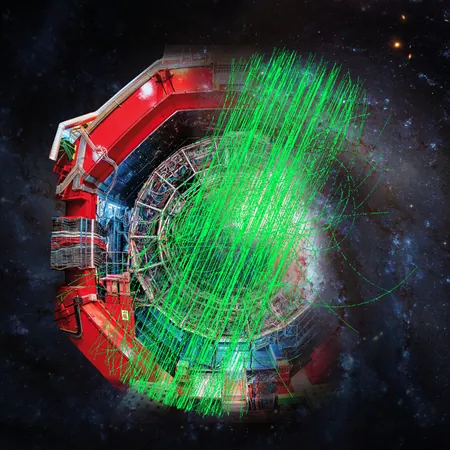
Unlocking the Cosmic Muon Mystery: Groundbreaking Findings from ALICE
2025-06-02
Author: Rajesh
A Cosmic Conundrum Unveiled
Cosmic rays, the high-energy particles hailing from the depths of outer space, bombard Earth’s atmosphere, leading to the creation of secondary particles like muons. Recently, scientists have been bewildered by the discovery that ground-based experiments are detecting far more cosmic muons than current theoretical models can explain—a phenomenon that has come to be known as the 'muon puzzle.'
The ALICE Experiment: A Hidden Gem
Located 52 meters underground at the Large Hadron Collider (LHC), the ALICE experiment is uniquely positioned to study these elusive cosmic muons. Shielded by a significant layer of rock and an iron magnet yoke, ALICE provides optimal conditions for muon detection, effectively filtering out other particles that arise from cosmic ray showers.
Staggering Discoveries: Millions of Muons Detected
In a recent publication in the Journal of Cosmology and Astroparticle Physics, the ALICE collaboration announced some astonishing data: approximately 165 million events featuring at least one cosmic muon, and over 15,700 events showcasing more than four cosmic muons. This remarkable data collection, conducted between 2015 and 2018 during down times of the LHC Run 2, amounted to about 62.5 days of observational time, significantly surpassing previous campaigns.
A Closer Look at Muon Multiplicity
By scrutinizing how the event count varies with the number of muons—referred to as muon multiplicity—the researchers observed a smooth decline from five muons up to fifty. Beyond this range, however, the statistics became less reliable due to dwindling event counts.
Comparing Models: Heavy Elements in the Spotlight
The ALICE team then compared their findings against three different models of secondary particle production, taking into account two extremes in the composition of primary cosmic rays: lighter protons and hefty iron nuclei. They discovered that the best match for their data was found when assessing iron as the primary composition, even though other models underestimated the event occurrence.
Toward a Deeper Understanding of Cosmic Ray Composition
While these findings suggest that heavier elements may dominate the cosmic ray composition, they also raise questions. The anticipated mixture of nuclear species and the expected increase in heavier elements with higher muon multiplicity challenges existing theories.
Rarity and Revelation: High-Multiplicity Events
Focusing on rare events featuring over 100 muons, researchers found satisfying correlation with two of the models when strictly considering an iron composition. This opens new avenues for understanding the energies at play—averaging around 100 PeV for the primary cosmic rays behind these extraordinary events.
The Cosmic Puzzle Continues
These revelations from the ALICE experiment not only deepen our understanding of cosmic muons but also point towards the exciting complexities of cosmic ray origins. As scientists continue to unravel this cosmic puzzle, the implications for particle physics and astrophysics remain profound, hinting at the mysterious forces shaping our universe.

 Brasil (PT)
Brasil (PT)
 Canada (EN)
Canada (EN)
 Chile (ES)
Chile (ES)
 Česko (CS)
Česko (CS)
 대한민국 (KO)
대한민국 (KO)
 España (ES)
España (ES)
 France (FR)
France (FR)
 Hong Kong (EN)
Hong Kong (EN)
 Italia (IT)
Italia (IT)
 日本 (JA)
日本 (JA)
 Magyarország (HU)
Magyarország (HU)
 Norge (NO)
Norge (NO)
 Polska (PL)
Polska (PL)
 Schweiz (DE)
Schweiz (DE)
 Singapore (EN)
Singapore (EN)
 Sverige (SV)
Sverige (SV)
 Suomi (FI)
Suomi (FI)
 Türkiye (TR)
Türkiye (TR)
 الإمارات العربية المتحدة (AR)
الإمارات العربية المتحدة (AR)